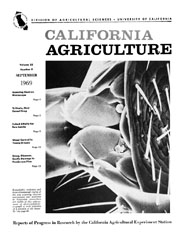


University of California
California Agriculture



|
|||
|
|||

Cover:
Remarkable resolution and three-dimensional clarity of the new scanning electron
microscopes now available to University researchers are visible in this enlargement of electron photomicrograph of male genitalia. of a parasite of the housefly.
September 1969
Volume 23, Number 9 |
|||
|
University of California, 1301 S. 46th St., Bldg. 478 Richmond, CA
|